In the digital era, baby footage is extremely precious. From a toddler’s adorable laugh to the first words of a baby or a funny diaper malfunction, everyone and the internet seem to adore it. Coupling the immense appeal of baby shows with the demand for podcasts is an idea waiting to be capitalized on.
Introducing: Baby Podcast Videos.
In this article, you’ll find the steps that help How to Make Viral Baby Podcast Videos makers go viral while maintaining a balance between entertainment and heart-touching scenes to maximize growth.
What is a baby podcast video?
Baby podcast video is a subcategory of video podcast where infants or babies with accompanying captions or voice-overs “speak,” respond, or react in a funny way. Different storytelling formats, interviews, and creative editing give these infants a humorous voice and showcase their cuteness.
These include:
- Animated baby clip storytelling
- Parent-baby interchange dubbed podcasts.
- Baby self-talking subtitles.
Joanne’s baby talk, where she imitates her child’s laughter and feeds her mindless babble, is over.
Dora the Explorer for Toddlers
Toy Version Of “K I Cut U Off” With a Talking Diaper Nabber.
Some of the most popular examples are the ‘twinning babies and they talk’ or animated baby fighting debates that utilize smart narrative, naive humor, and creative eye-catching designs.
Finding the interesting reason as to why podcasts geared toward children go viral can be simple.
Let’s look into the aspects determining the success and popularity of baby podcasts:
Emotional connection: The unconditional love and affection for a baby instantly puts a smile on people’s faces. June 28th, 2021.
Emotional Content: Baby and baby-related content is filled with cuteness or humor; baby and baby-arranged material is very relatable.
Posting this type of thing on social media will gain Instagram-famous social media pages provide funding, and socially relevant material makes strong waves.
A baby laughing can instantly bring a smile to people’s faces, lifting spirits across cultures, as it is a well-loved act.
Step-by-Step Guide Towards Creating a Viral Baby Podcast Episode.
Step 1: Research Your Audience
Focus on the aimed users positioned where the content has meaning. Look to this for guidance:
Taking care of a baby.
Looking for something lighthearted.
Being a grandparent.
Social Networks Provided by Parents:
The tone of the content changes depending on the audience: should it be blended, a touch of humor, emotions, education, or entertainment?
Step 2: Gather Baby Content With Notable Useless Criteria
Use usable clips and a baby’s sustaining pieces to the family. Aim to work as approved advisors accessible to record babies being marked off parents and children working together.
Aim to hit the questions listed below:
Step 3: Pick a Theme or Storyline
A theme helps your video to be more coherent and is easier to share. From the list provided, choose one of the popular formats:
“Baby News Anchor”: Dress the infant as a newscaster and have them voiced over in a cute manner.
“Interview with a Baby”: Play an inquisitive parent and we subtitle the baby’s coos and sounds.
“Baby Reacts to…”: Capture the baby’s facial expressions when feeding or introducing new pets or sounds.
“Parent vs. Baby Debate”: Edit and voiceover a funny argument.
Standing out with a clear concept will help set your video apart.
Step 4: Record and Edit Like a Pro
🎤 Voiceovers
In the event that your little angel isn’t able to talk yet (which is usually the case), you can make use of voiceovers. Here are some tools to help:
Voicemod (silly, comedic voices)
Adobe Audition (serious audio editing)
Free mobile CapCut/InShot apps.
Voiceovers need to be
Clear
Well articulated
In sync with facial expression of the baby
Age-appropriate
Friendly for family setting
Use Good Editing Software
Even simple editing makes a huge difference. Use:
CapCut because it is no cost and easy to use, unlike.
Adobe Premiere Pro for advanced editing.
Final Cut Pro for those who use Mac.
InShot or iMovie for mobile creators.
What to Edit:
Replace boring parts
Subtitles (important for user engagement)
Use soft background music
Add zooms, emojis, or sound effects
✂ Make It Short and Sweet
Ideal length for Instagram/TikTok: 30 seconds to 1 minute
YouTube Shorts: less than a minute
Facebook/YouTube: Longer videos (1-3 minutes) work too as long as they’re engaging.
Step 5: Add Titles and Descriptions
Your title is the first impression. Make it clickable!
Examples:
“This Baby Just Gave the Cutest Interview Ever 😂🎤”
“Baby Reacts to Dad’s Singing—You Won’t Stop Laughing!”
Breaking News: Baby Reports from the Highchair 🍼
Use description with hashtags such as: #babypodcast #cutebaby #funnybaby #viralvideo #babytalk #parentinglife
Step 6: Wrong Platforms
Different platforms give you different reach.
🟪 TikTok
Best use for content with a chance to go viral. Use trending sounds and short formats.
🟥 Youtube Shorts
Great for creating long-term audiences, optimize titles and end screens.
🟩 Instagram Reel
Parenting and baby content has a huge audience here; use appropriate hashtags and geotags.
Post in parenting groups and communities; video content is boosted in Facebook Watch.
📱 Bonus: Threads or X (formerly known as Twitter)
Embed humorous screenshots or quotes from your clips.
Step 7: Engage With Your Audience
General virality does not occur simply by posting content; it also deals with replying and interacting.
Respond to comments
Post engagement questions: “What should Baby Podcast talk about next?”
Prominently display your best comments
Motivate users to tag other people
When you interact with your audience, your watch time increases and your video is pushed higher on algorithm rankings.
Step 8: Stay Consistent
Viral videos tend to get attention, but people appreciate watching a well-structured episodic series.
Establish a clear schedule for when to post content, weekly or biweekly. Attempt to achieve:
“Baby Podcast Mondays”
“Friday Baby Reactions”
“Mini Baby Interviews Every Sunday”
Having a scheme such as this has trust benefits and increases the likelihood of shares.
Step 9: Collaborate With Other Creators
Join forces with:
Other parents
Creators of baby content
Voiceover actors
Influencers targeted for kid-friendly content
Cross-promotion is beneficial for everyone to grow at a quicker rate.
Step 10: Monitor and Improve
Since every platform offers the following:
YouTube Studio
TikTok Analytics
Instagram Insights
Facebook Creator Studio
Utilizing these tools will enable you to keep track of
View count
Watch time
Shares and saves
Audience retention
Refining video content focuses on repeat viewers if data suggests strong performance.
Additional Tips for Increased Chance of Virality
Strategies for increased chance of going viral, also known as “secret sauces,” include:
Using trending sounds, especially on TikTok or Reels.
Post When Traffic is High: Evenings and weekends typically have the highest engagement.
Using Humor + Emotion Together: Viral videos tend to make you laugh as well as cry.
Use Thumbnail Testing: Put an expressive face with bold text on the thumbnail for YouTube.
Add the Most Relatable Captions: “POV: When your baby hears the word ‘snack.’”
Ethics: Baby Caring and Consent
Do not orchestrate viral moments that might be deemed uncomfortable by other people. Children’s safety and emotional well-being trump everything, including
Do not reveal overly private information like bathing or tantrum sessions.
Don’t use your child’s full name or the general area where they live.
Turn off comments if it opens the floor to troll conversations.
Let everything remain cheerful and free. The best memories are unplanned.
In Conclusion: “The Effect of Podcast Videos on Babies”
The work behind a viral baby podcast video is tuning in to the webcam and hitting record—no, it’s a lot more than that. It’s a meticulous balance of creativity, narrating, fine-tuning, and emotion.
Related Post.
How to download the Remini Pro application
For audio generation,
For image to video



